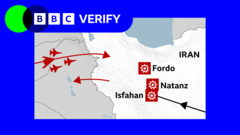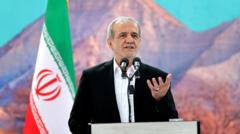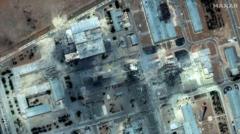US military officials have revealed how Operation Midnight Hammer was orchestrated, involving advanced stealth technology and strategic deception to strike at Iran's nuclear capabilities, though the long-term implications remain uncertain.
Operation Midnight Hammer: A Closer Look at the US Strikes on Iran's Nuclear Facilities

Operation Midnight Hammer: A Closer Look at the US Strikes on Iran's Nuclear Facilities
Detailed insights into the US military's secretive operation targeting Iran’s nuclear sites amid rising geopolitical tensions.
The United States military recently executed a complex operation, dubbed Operation Midnight Hammer, targeting Iran's nuclear facilities, as outlined by General Dan Caine, the Chairman of the Joint Chiefs of Staff. The operation involved meticulous planning and execution, which included extensive flights, coordinated mid-air refueling, and a unique use of decoys to achieve surprise.
According to a detailed Pentagon briefing, the operation commenced just after midnight. Key figures, including Secretary of Defense Pete Hegseth and President Donald Trump, closely monitored the mission from the White House Situation Room as B-2 stealth bombers took off from Whiteman Air Force Base. These bombers, equipped with advanced bunker-buster bombs designed to penetrate deep underground facilities, aimed at Iran's highly secured Fordo nuclear site.
While the bombers approached from the Atlantic, a secondary group of planes flew towards the Pacific as part of a distraction strategy to mislead observers about the actual operation. As detailed by General Caine, this deception was limited to a small number of planners, allowing the main assault force to proceed with lower visibility and communication lines.
Upon reaching Iranian airspace, the bombers executed their first strike at approximately 6:40 PM EDT, focusing on the Fordo site and the Natanz facility. Around that time, more than two dozen Tomahawk missiles were also launched from a US submarine targeting locations near Isfahan. This simultaneous strike was designed to overwhelm Iranian defenses, which, according to US officials, posed little to no threat during the operation.
Upon execution, the US proclaimed a significant tactical victory, asserting that Iran's nuclear capabilities had been severely diminished. However, Iranian officials have downplayed the extent of the damage, creating uncertainty regarding the aftermath and the effectiveness of the operation in achieving long-term goals regarding Iran's nuclear ambitions.
Although the military successfully employed a highly coordinated approach involving 75 precision-guided weapons and over 125 aircraft, experts stress the need for further investigation into the damage inflicted. The sophistication and complexity of the operation highlight capabilities that few nations can replicate, yet the US military and analysts remain cautious about the definitive impact on Iran's nuclear program in the future.
The true measure of success for Operation Midnight Hammer will not be immediately evident, as the US military continues to analyze the operational results and strategize its next steps in the potentially volatile context of US-Iran relations.





















